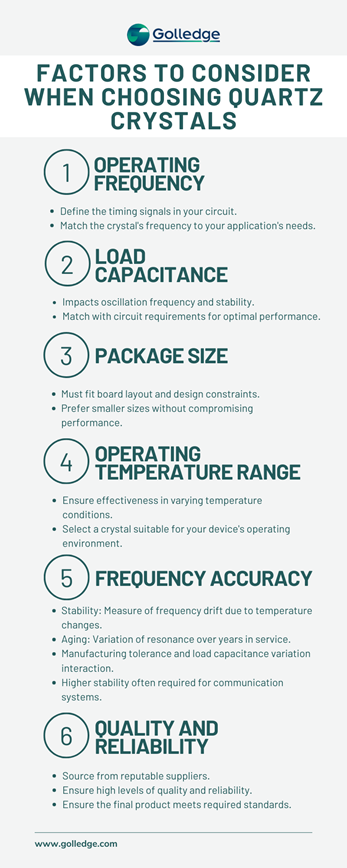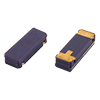The Advantages of Using High-Quality Quartz Crystals in Your Electronic Design
7 Jun 2023
KATIEJENKIN@GOLLEDGE.COM
Frequency control products are truly the unsung heroes of electronic devices, working hard in the background to ensure the precision, reliability, and coordination of our devices' digital operations.
Among these frequency control products is the humble quartz crystal ,
Owing to their unique physical properties, quartz crystals play an indispensable role in maintaining the consistent rhythm of our digital lives. An essential player in the operation of digital clocks and devices, the quality of the quartz device should not be overlooked, or else your end-product faces issues over reliability, function and precision.
In the UK, the name synonymous with quality and innovation in this sector is Golledge Electronics. As the nation's leading supplier of frequency control products , our team here at Golledge has established an enviable reputation through our unwavering commitment to customer requirements and our aspiration to exceed them continually.
Our offerings span a broad spectrum of products, many harnessing the precision of quartz crystals to deliver optimal performance and reliability in all their applications.
In this guide to quartz crystals, we’ll look further into what exactly they are, how they function, the importance of quality and the most important factors to consider when choosing quartz crystals for your electronic product.
Read below to improve your understanding of quartz crystals.
What is quartz devices?
Quartz is a naturally occurring mineral, recognised for its geometric perfection and piezoelectric properties.
This piezoelectricity refers to the crystal's ability to generate an electric charge in response to mechanical stress or pressure, or viceversa—a trait that finds enormous value in a multitude of electronic applications.
The interior of a quartz crystal is a world of symmetrical harmony. Its structure is a continuous, repeated pattern of silicon-oxygen tetrahedra, forming a solid framework that is both robust and transmits vibrations with very low loss. When an alternating electric field is applied to such a crystal, it undergoes a deformation generating an acoustic wave.
The shape, size and the angle of the cut relative to the crystal lattice set the resonant frequencies of the crystal. Because the piezoelectric effect works in both directions the mechanical resonance is mirrored as an electrical one.
This is where the beauty of quartz truly lies, in its capacity to maintain a consistent frequency, granting it a pivotal role in the world of electronics.
The Application of Quartz Crystals in Frequency Control Products
Quartz crystals serve as the core component in frequency control products due to their ability to produce stable, reliable vibrations. They are the heart of most oscillators, the ticking mechanisms that give our digital devices their tempo.
The dependable frequency of quartz ensures the timing precision required for electronic systems to function cohesively.
In oscillator circuits, quartz crystal devices function as resonators—creating a circuit that resonates at a precise frequency when an alternating current is applied. This frequency serves as a timing reference for electronic devices, from simple time-keeping devices like wristwatches to complex systems in computers, telecommunications equipment, and global positioning systems (GPS).
Here at Golledge Electronics, we leverage the unique properties of quartz crystals in our wide range of frequency control products.
Whether it's Quartz Crystals, Oscillators, TCXOs , Crystal Filters , SAW Filters , or RTC Modules , the common thread is the use of high-quality quartz crystals in our product offerings.
The Science Behind Quartz Crystals
To truly appreciate the value that quartz crystals bring to our digital world, it's important to delve into the key scientific principles that enable their function: the piezoelectric effect and the notion of quartz crystal resonators.
The Piezoelectric Effect
The piezoelectric effect is a remarkable phenomenon where certain materials, such as quartz, generate an electric charge when subjected to mechanical stress. In a quartz crystal, this effect is reciprocal—meaning an applied electric charge will cause the crystal to deform and vibrate.
The magic of quartz crystal lies in its ability to conduct these vibrations with almost no loss. Because it is so hard and stable it can be very precisely shaped into resonators with a very high Q, that have very little variation with temperature. The exact shape, size, and cut of the crystal will determine its resonant frequency.
Quartz Crystal Resonators
These exact and consistent oscillations make quartz crystals ideal for use as resonators in oscillator circuits.
When an alternating current of a matching frequency is applied to a quartz crystal, it vibrates or resonates, creating an electrical output with a highly stable frequency. This is the heartbeat of many of our electronic devices, providing the timing signals that ensure everything from data transfer to audio and video synchronisation happens as it should.
The Advantages of Using Reliable Quartz Crystals in Electronic Design

The adoption of high-quality quartz crystals in electronic design is a strategic move aimed at harnessing their superior attributes.
The advantages of utilising these components are vast, spanning precision, stability, durability, and cost-effectiveness.
Precision and Stability
High-quality quartz crystals offer exceptional frequency stability and precision.
As the heart of an oscillator, a quartz crystal provides a precision resonance to create timing reference that is crucial for synchronising operations within an electronic system. The reliability of this 'heartbeat' is paramount in applications that demand high precision, such as telecommunications, computer processing, and GPS technologies.
Cost-Effective
Despite their impressive performance characteristics, quartz crystals are relatively inexpensive . Their abundant availability and ease of fabrication make them a cost-effective option for many applications, offering a high performance-to-cost ratio.
Durability
Quartz crystals are incredibly durable, withstanding harsh operating environments and physical stress better than many other resonant materials.
This resilience makes quartz an attractive choice for products intended for use in conditions ranging from extreme temperatures to high-vibration settings.
What is quartz used for? Real-Life Applications of Quartz Crystals
Now, where can you find these crystals at work? The answer is closer than you might think. The stable heartbeat of quartz can be found in everyday electronic devices, controlling timing and frequency. So, how are crystals used in technology?
Consider your wristwatch. Its ability to keep precise time hinges on a quartz crystal resonator that oscillates exactly 32,768 times per second. This precision allows the watch to accurately track the passage of time, second by second, minute by minute.
In the world of telecommunications, quartz crystals are instrumental in ensuring data is transmitted and received at the correct times and on the correct frequency. Whether it's a mobile phone call, a television broadcast, or an internet connection, the precise timing provided by quartz crystals is fundamental.
Similarly, in GPS technology, quartz crystals are used to produce highly stable frequencies that allow precise triangulation of signals from satellites to determine location with impressive accuracy.
In the domain of computer systems, the processor's clock, locked to a quartz crystal oscillator, ticks billions of times per second to coordinate the computer's operations. This clock ensures instructions are executed in the correct order and at the right time, allowing the computer to function correctly.
From keeping time to enabling global communications and navigation, high-quality quartz crystals are central to the operation of our modern electronic world.
Factors to Consider When Choosing Quartz Crystals

Selecting the appropriate quartz crystal for your application is no small task. Your choice will have a substantial impact on your device's performance.
Whether you're a seasoned engineer or an enthusiastic hobbyist, it's crucial to be aware of the key factors that can influence your choice of quartz crystals. We’ve listed some of the top factors to consider below:
Operating Frequency: This is the frequency at which your crystal will oscillate, and it's crucial in defining the timing signals in your circuit. Each application will require a different operating frequency, so you must choose a crystal that matches your specific needs.
Load Capacitance: This refers to the amount of capacitance the crystal will see in your circuit. It impacts the oscillation frequency and overall stability of the crystal, so it's important to match the crystal's load capacitance with your circuit's requirements.
Package Size: The package size of the crystal must fit your board layout and other design constraints. With technology trending towards miniaturisation, smaller crystals are often preferable, but they should not compromise on performance.
Operating Temperature Range: When selecting a quartz crystal, consider the temperatures your device will be exposed to in operation, and ensure the crystal can perform effectively in these conditions.
Frequency Accuracy: Frequency Accuracy is a combination of factors consisting of Stability, a measure of how much a crystal's frequency might drift due to temperature changes, aging (the slow variation of resonance over the years your product in in service), manufacturing tolerance, and how load capacitance variation in your circuit interacts with Tuning Sensitivity of the crystal. Depending on your application, you might require a quartz crystal with higher frequency stability. For instance, communication systems often require higher stability compared to consumer electronics.
Quality and Reliability: It’s essential to source your crystals from reputable suppliers to ensure high levels of quality and reliability so that the final product is to the standard that you want and need.
Partnering with Golledge Electronics for reliable quartz devices
As we’ve discovered, choosing the right quartz crystal for your specific application is a nuanced task that demands a thoughtful consideration of several factors, including:
- Operating frequency
- Load capacitance
- Package size
- Operating temperature range
- Frequency stability
- Quality and reliability.
In this regard, Golledge Electronics stands as a trusted partner for those looking for high quality quartz crystals and other Frequency Control Products. By taking advantage of our services and product offerings, you can confidently produce products that perform reliably under all conditions and deliver electronic designs that truly stand out.
Find out more about ordering Golledge products or get in touch with our sales team directly to discuss your project in more detail.


